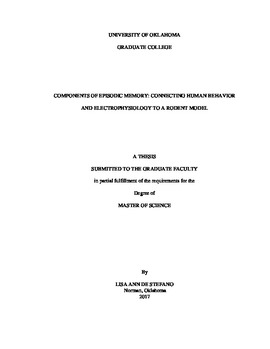| dc.description.abstract | Episodic memory encoding and retrieval rely on integration of information about what
an item was, as well as when and where it was encountered. Previous research from
animal lesion studies using a novelty preference paradigm found that the hippocampus
and medial prefrontal cortex were critical for different aspects of recollection of
episodic events (DeVito & Eichenbaum, 2010). The present study attempts to adapt this
paradigm to assess these components behaviorally and electrophysiologically in humans
using a memory recognition task. Participants studied two virtual “rooms” containing
images of women, with each image presented consecutively in a random location for 5
s. Between rooms, participants engaged in a go/no-go distractor task for either 15 s
(“short” retention interval) or 3 m (“long”). After both rooms were studied, participants
made old/new judgments with half of the items being new. Half of the images appeared
in the same location as during the study phase (“stationary”) with the others appearing
in a new location (“displaced”). Behavioral results showed no difference in reaction
time (RT) between old and new items, but significantly longer RTs for displaced items
relative to stationary, and significantly longer RTs for items seen before long retention
intervals than short. Electrophysiological (EEG) results show no main effect of old/new
status in a memory-related ERP in the left parietal area, but did show a main effect of
displacement, with items that were displayed eliciting smaller amplitudes than items
that were stationary. Additionally, trial-by-trial regression analyses uncovered sets of
electrodes that were responsive to manipulations in retention interval and study room
(memory for “when”), as well as displacement at test (“where”). | en_US |
